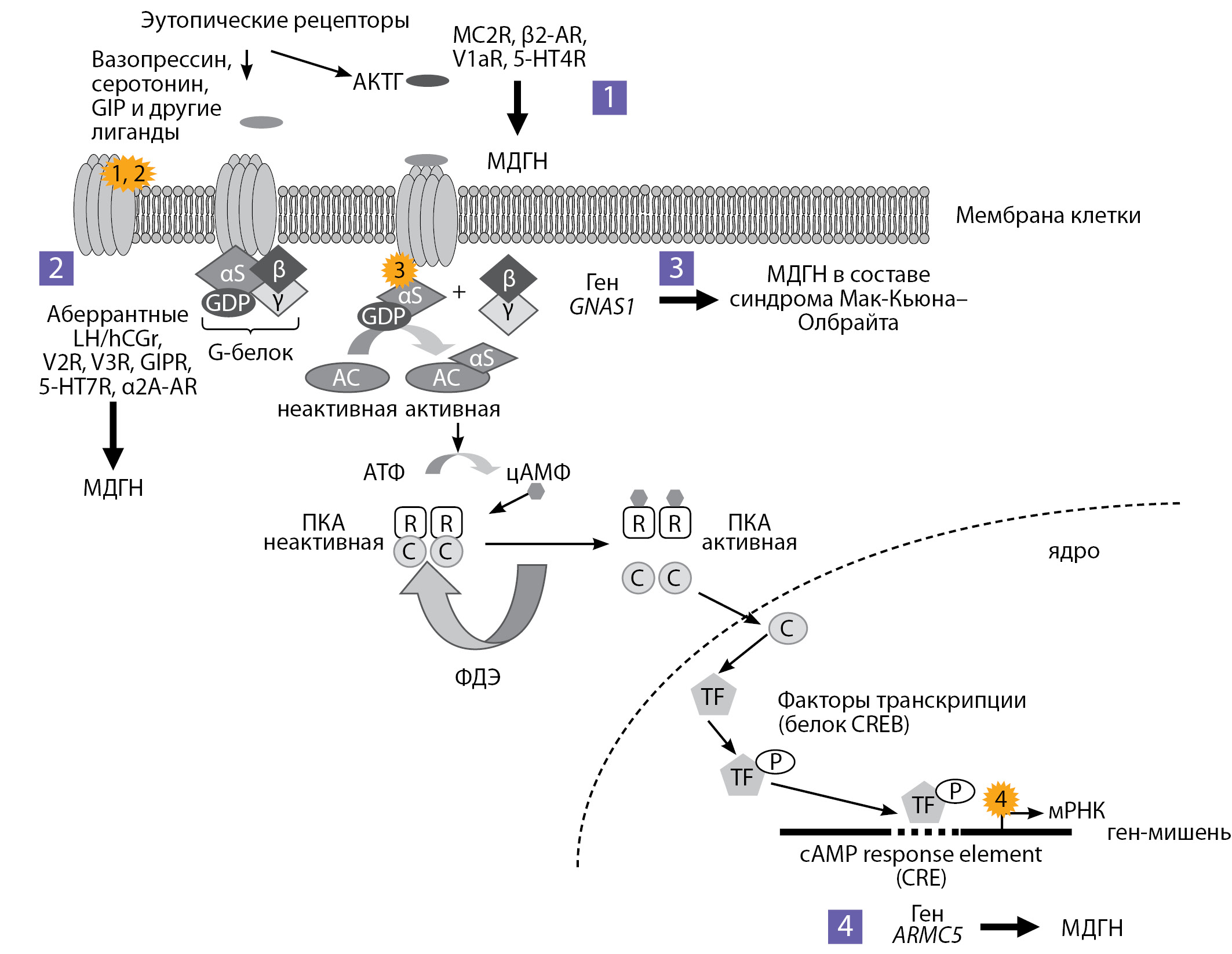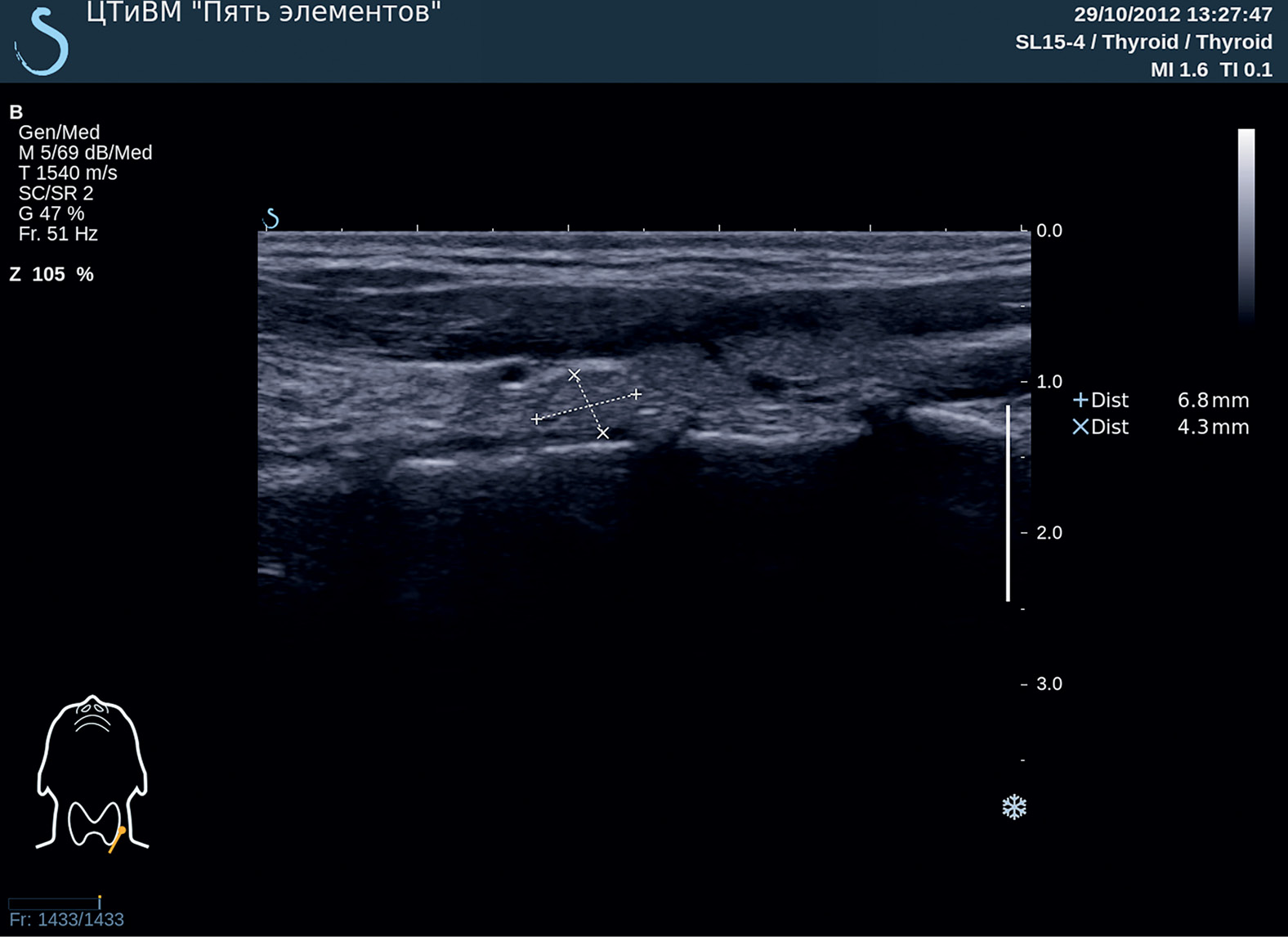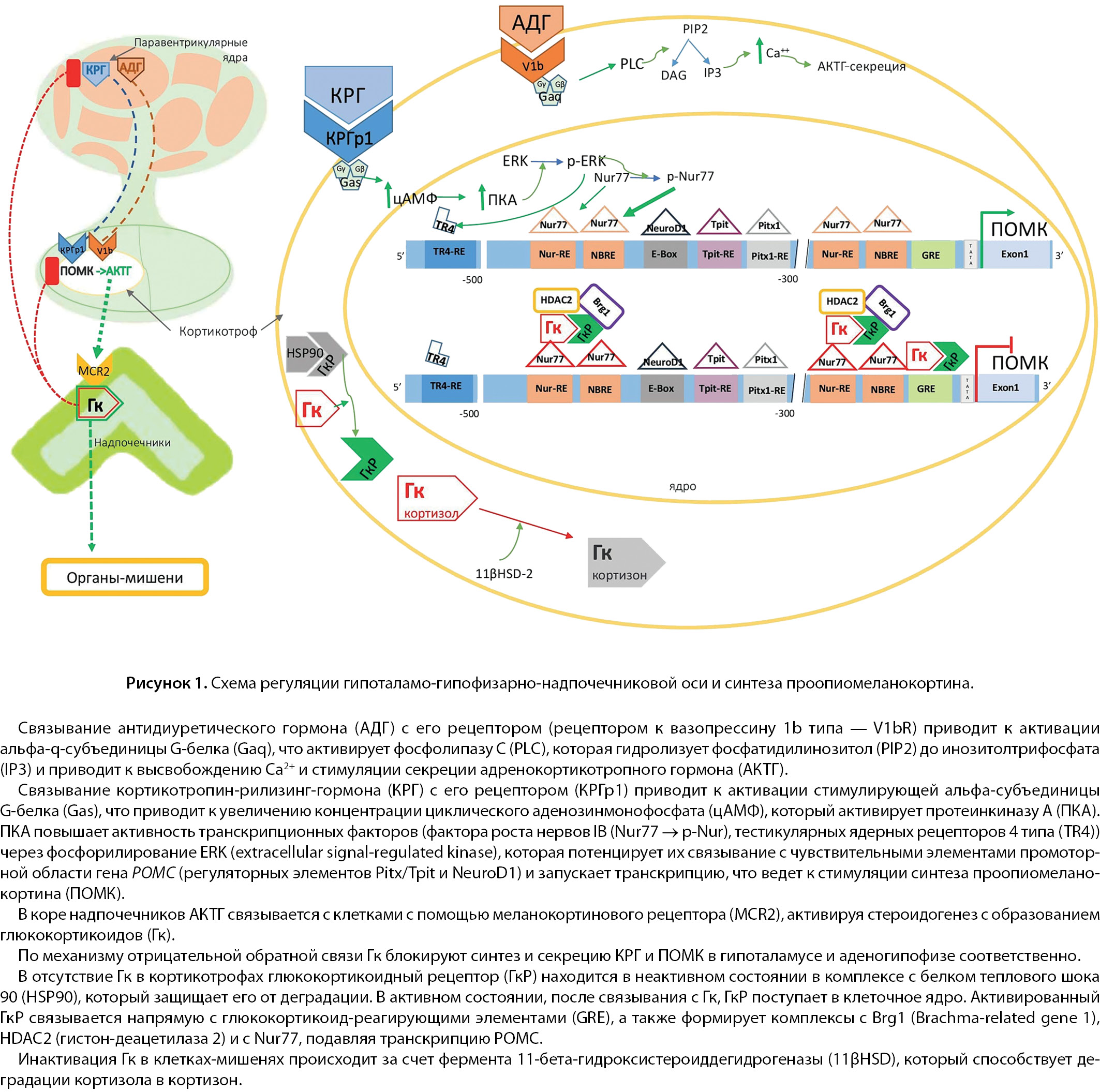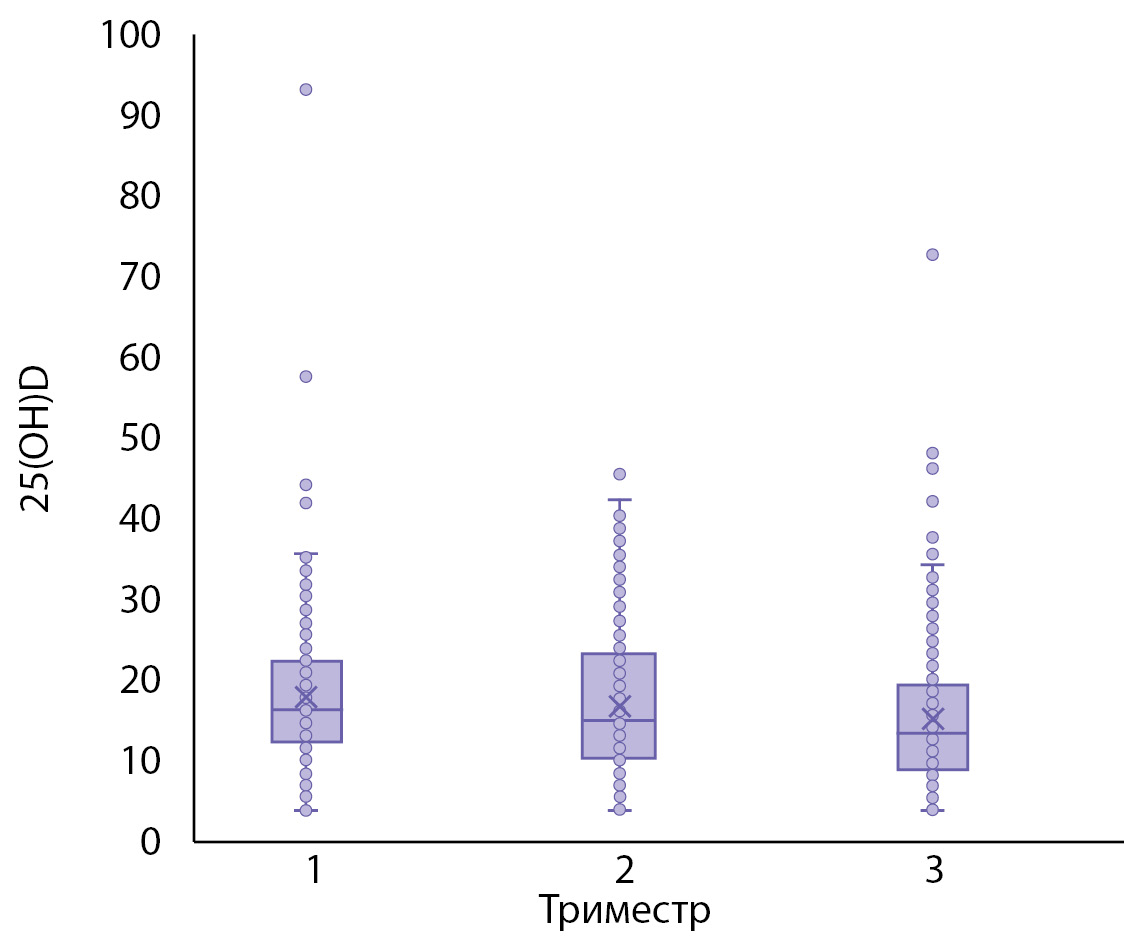Clinical endocrinology
Bilateral macronodular adrenal hyperplasia (BMAH) is a rare cause of Cushing’s syndrome. In this case cortisol production can be regulated by both genetic factors and various molecular mechanisms. The presence of aberrant or overexpression of eutopic receptors on the membrane of adrenal cortex may lead to activation of cAMP/PKA signaling pathways and consequently, pathological stimulation of steroidogenesis. Since proving the effectiveness of unilateral adrenalectomy in BMAH by achievement of stable remission, preoperative clinical and laboratory tests (ligand-induced tests) are no longer of relevant. Nevertheless, in the absence of normalization of the level of cortisol in the postoperative period or its recurrence, subsequent specific targeted medical options can be offered only if expression/hyperexpression predominance of one or another receptor. Their detection becomes possible using more reliable diagnostic methods such as polymerase chain reaction (PCR) and immunohistochemical studies (IHC) than clinical laboratory tests. At the moment, PCR has gained a wider application. This article summarizes data on the use of immunohistochemical study in BMAH.
Idiopathic hypercalciuria is a heterogeneous generalized disorder caused by various defects in calcium transport and increased urinary calcium excretion. The main etiopathogenetic factors are violations of vitamin D metabolism, changes in the sensitivity of calcitriol receptors and violations of the processes of calcium reabsorption in the proximal tubules and in the ascending knee of the Henle loop. This article presents a clinical observation of patient with idiopathic hypercalciuria, initially high levels of parathyroid hormone (PTH) in the absence of hyperparathyroidism. Therapy with thiazide diuretics allowed to achieve normalization of daily urinary calcium excretion and reducing PTH. Despite the low prevalence of idiopathic hypercalciuria, differential diagnosis of this metabolic disorder should be carried out with mandatory consideration of clinical and laboratory data, as well as with diseases that may cause increased PTH production.
Carbohidrates metabolism disturbancies
Kidney transplantation is unique method of renal replacement therapy, allowing to improve quality and duration of life for patients with diabetes mellitus type 1 (DM1) and end-stage renal disease (ESRD) on dialysis therapy. Recently using of innovation technologies for diabetes management and modern immunosuppression enable achieving better results of posttransplant rehabilitation for patients with DM1, especially if kidney transplantation is performed early after initiation of dialysis. Detailed examination of patient with DM1 before potential kidney transplantation is very important to reduce of early and late postoperative complications. Kidney transplantation preparation includes effective glycemic control, adequate dialysis therapy, treatment of diabetes and ESRD complications and concomitant conditions, especially cardiovascular diseases, accounting for kidney transplantation perspective. Furthermore, diagnostics and treatment of any infectious process, timely vaccination, cancer screening are basic approaches of kidney transplantation preparation program, providing the best survival rate of kidney graft and patient.
Pediatric Endocrinology
The article reviews scientific papers devoted to the problem of reproductive health in men with Klinefelter syndrome (KS). Pathogenesis from a very early age (in utero), the possibility of ensuring biological paternity upon reaching sexual maturity and the risk of chromosomal abnormalities in offspring are discussed. Despite the fact that KS is one of the most common causes of male infertility associated with chromosomal abnormalities, due to the variability of clinical manifestations the proportion of patients identified before puberty did not exceed 10% before the widespread introduction of non-invasive prenatal testing. According to the research results presented in the article, the reproductive potential of males with KS is often already reduced in early childhood. These circumstances should be considered when choosing further patient management tactics.
There are few reports on the onset of spontaneous pregnancy in the case of KS, so ensuring biological paternity in this group of patients is often possible only using surgical methods of sperm extraction and assisted reproductive technologies. This article discusses methods like testicular sperm extraction (TESE) and microdissection testicular sperm extraction (mTESE) in terms of their effectiveness and safety for the patient, and the factors influencing the outcome of the operation. The optimal period of these manipulations seems to be the patient’s age from 18 to 30 years, although the feasibility of adolescent boys undergoing the aforementioned procedures is highly controversial.
The research papers presented in the article suggest that the risk of transmitting chromosomal abnormalities to offspring is rather low, which does not exclude the need for medical and genetic counseling to explain all possible risks to the patient. Preimplantation or intrauterine diagnostics are also deemed necessary.
Cushing’s disease (CD) is a multisystem disorder of a cortisol excess caused by ACTH -secreting pituitary tumor (corticotropinoma). CD in children is due to somatic or germline mutations with the late onset causing multiple endocrine tumors. If not treated, hypercortisolism leads to severe decrease in quality of life and life-threating conditions. The first-line treatment for CD is pituitary surgery, which might be followed by complications and relapse with necessity of additional surgery or initiations of second-line treatment. Recent studies of molecular basis of corticotropinoma development made it possible to employ medical therapy in CD. Understanding of corticotropinoma etiology and pathogenesis is an important part of education for pediatric endocrinologists since we need to keep in mind possibility of multisystem disorder in case of CD in children and because medical therapy might gain more important role for CD treatment in future.
The most actual genetic aspects of corticotroph adenomas growth and the medical treatment opportunities are present in this review.
BACKGROUND: Diagnostics of growth hormone deficiency (GHD) and secondary adrenal insufficiency (SAI) is based on estimation of peak GH and cortisol concentrations in provocation tests. Russian consensus on diagnostics and treatment of hypopituitarism in children and adolescences recommends to measure GH and cortisol concentrations in every time-point of insulin test (IT). Glucagon test (GT) is discussed in literature as alternative to IT.
AIMS: To estimate the possibility to use provocation GT for diagnostics of SAI and GHD in children and adolescents.
MATERIALS AND METHODS: We investigated blood and urine cortisol levels, IT, and GT in 20 patients 6.5–17.8 years (Me 13.0 (10.4; 15.3)) after surgery and/or radiology and/or chemical therapy of head and neck tumors; remission for 0.4–7.5 years (Ме 2.1 (1.5; 5.2)).
RESULTS: With cut-off point 550 nmol/L sensitivity and specifity of IT was 100% and 60%, GT — 100% and 53% respectively. Minimal cortisol cut-off level for GT with sensitivity 100% was 500 nmol/L, maximal with specifity 100% — 400 nmol/L.
Early morning cortisol levels did not exceed 250 nmol/l in 2 patients with SAI; and were above 500 nmol/l in 8 patients without SAI while primary or repeated examination.
GHD was reviled by IT in all patients. Maximal GH concentrations in GT and IT did not differ significantly (p>0.05) but GT results of 4 patients exceeded or met cut-off for this test (7 ng/ml).
GT was characterized by less severity compared with IT.
CONCLUSIONS: For diagnostics of SAI by GT we can advise cut-off points of cortisol level 500 (sensitivity 100%, specifty 53%) and 400 nmol/L (sensitivity 80%, specifity 100%). Measuring of cortisol levels in 2–3 early morning blood samples allows to exclude or to suspect SAI in half of patients before tests. GH peaks in GT can exceed similarly data in IT that needs future investigation.
Disorders of sex development (DSDs) are congenital conditions in which phenotype does not correspond to chromosomal and gonadal sex. To date, the etiology of DSD is established only in half of the cases. With the development of modern methods of molecular genetic diagnostics in the last decade, a number of new regulators of gonad differentiation have been discovered, whose expression disorders can lead to DSD. Among these factors, Mitogen-activated triple protein kinase 1 (MAP3K1). A distinctive feature of studying the detected variants in the MAP3K1 gene that they lead to activation of MAP3K1. It does not allow using generally accepted pathogenicity assessment algorithms. However, the frequency of detection of changes in MAP3K1 is up to 18% of all cases of DSD, according to literature, which emphasizes the importance of studying each identified case, establishing the relationship of the disease with the identified genetic disorders. In this article, we present a clinical, hormonal, and molecular genetic description of 7 cases of DSD associated with variants in MAP3K1, an analysis of the significance of our own data, and a short analysis of the current scientific literature on this issue.
Reproductive Endocrinology
There is no universal diagnostic and treatment strategy of subclinical hypothyroidism (SHT) in pregnant women and those who are planning pregnancy due to differences in population-specific and trimester-specific thyroid-stimulating hormone (TSH) reference values, influence of thyroid autoimmunity markers on pregnancy outcomes, adherence to fixed universal cutoff concentrations TSH in Russia and multidisciplinary team care with different treatment opinions involving. An absence of universal approach to SHT leads to excess treatment, financial and psychological burden on pregnant women.
Up to American Thyroid Association (ATA) Guidelines 2017 and project of Clinical Guidelines of Russian Association of Endocrinologists 2019 a treatment strategy of SHT should be left up to the endocrinologist to choose. In our paper we systematize global scientific and clinical experience of planning and management pregnancies with SHT to help physicians to choose treatment option based on principals of evidence-based medicine.
Polycystic ovary syndrome (PCOS) is the most common cause of female endocrine infertility. Insulin resistanсе is supposed to be one of the essential factors of this disease pathways. At the same time, the mechanisms of PCOS development in insulin-resistant patients have not been completely established. Leptin and Peroxisome Proliferator-Activated Receptor γ(PPARγ) are involved in carbohydrate metabolism and reproduction function regulation. It indicates that leptin and PPARγ possibly play a role in the pathways of PCOS. This article is a review of publications on this issue. The purpose of this review was to systematize the available information on the molecular mechanisms that determine the role of leptin and PPARγ in the development of PCOS. The literature search was carried out from 04/05/2020 to 05/17/2020 using the scientific literature databases: NCBI PubMed (foreign sources) and Cyberleninka (domestic sources). We analyzed publications for the period 1990-2020.
The review presents the current understanding of the possible role of leptin and PPARγ in the regulation of endocrine, immune systems, and reproductive function, as well as in the development of PCOS. Currently, no studies cover the mechanisms of interaction between leptin and PPARγ in the pathways of this syndrome. The available studies indicating the individual contribution and association of leptin and PPARγ with PCOS are conflicting and have many limitations. Therefore, more studies of direct and indirect interaction of leptin and PPARγ, as well as their role in PCOS pathways, are needed.
BACKGROUND: It has been proven that vitamin D plays an important role in pregnancy. Deficiency of this element may be associated with the risk of developing gestational diabetes mellitus, preeclampsia, placentar insufficiency, low birth weight and premature birth.
AIMS: To conduct an epidemiological analysis of vitamin D supply in women at different stages of pregnancy, living in Russia.
MATERIALS AND METHODS: We included 1198 pregnant women living in 3 regions of Russia in the observational, multicenter, cross-sectional, continuous study. All pregnant women were tested for serum 25(OH)D levels. We collected biomaterial from August 2018 to December 2019. The end point of the study was the indicator of vitamin D supply in pregnant women and its level depending on the trimester of pregnancy and region of Russia. Statistical analysis included counting and grouping according to vitamin D levels, and calculating the median vitamin D concentration in each region.
RESULTS: We confirmed vitamin D deficiency in all regions. The optimum level of this element is present in less than 7% of women. Insufficiency of this element is present in 20,62% of all women. The largest percentage of them is in a deficit of this element — 46,66%. We found that the lowest rates are in Smolensk, where the median was 12,75 ng/ml. In addition, we found changes in vitamin D concentration: with an increase in gestational age revealed a decrease in its level.
CONCLUSIONS: In our study, we confirmed the presence of a 25(OH)D deficiency in most of the examined pregnant women, which is consistent with international epidemiological data. We should remember about these both at the stage of pre-gravid preparation and at the stage of pregnancy itself in order to achieve the optimal level of vitamin D.

This work is licensed under a Creative Commons Attribution-NonCommercial-NoDerivatives 4.0 International License (CC BY-NC-ND 4.0).
ISSN 2308-1430 (Online)












































.jpg)


